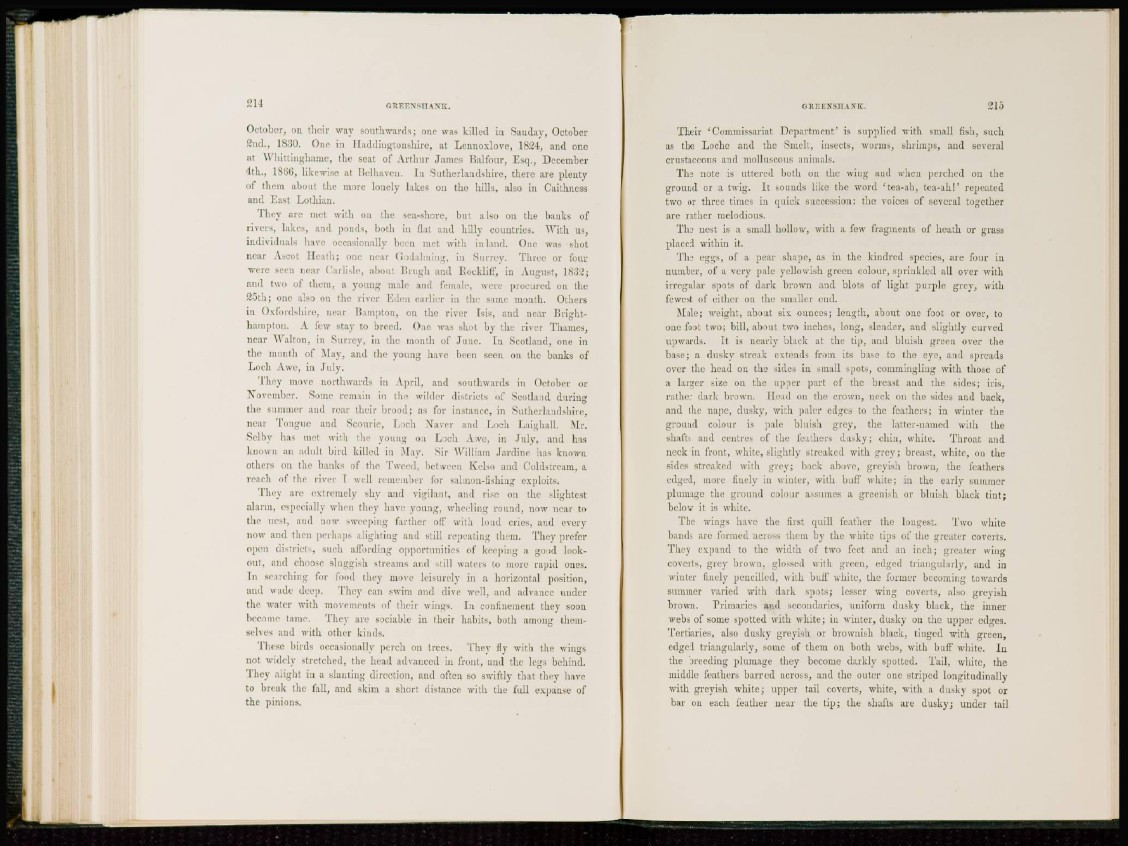
214 GREEK SHANK.
October, on their way southwards; one was killed in Sanday, October
2nd., 1830. One in Haddingtonshire, at Lennoxlove, 1824, and one
at Whittinghame, the seat of Arthur James Balfour, Esq., December
4th., 1866, likewise at Belhaven. In Sutherlandshire, there are plenty
of them about the more lonely lakes on the hills, also in Caithness
and East Lothian.
They arc met with on the sca-shore, but also on the banks of
river-, lakes, and ponds, both in flat and hilly countries. "With us,
individuals have occasionally been met with inland. One was shot
near Ascot Heath; one near Godalming, in Surrey. Three or four
were seen near Carlisle, about Brugh and Bockliff, in August, 1832;
and two of them, a young male and female, were procured on (he
25th; one also on the river Eden earlier iu the same month. Others
in Oxfordshire, near B unpton, on the river Isis, and near Brighthaniplon.
A few stay to breed. One was shot by the river Thames,
near Walton, in Surrey, in the mouth of June. In Scotland, one in
the month of May, and the young have been seen on the banks of
Loch Awe, in July.
They move northwards iu April, and southwards in October or
November. Some remain in the wilder districts of Scotland during
the summer and rear their brood; as for instance, in Sutherlandshire,
near Tongue and Scourie, Loch Naver and Loch Laighall. Mr.
Sclby has met with 'be young on Loch Awe, in July, and has
known an adult bird killed in May. Sir William Jardine has known
others on the banks of the Tweed, between Kelso aud Coldstream, a
reach of the river I well remember for salmon-fishing exploits.
They are extremely shy and vigilant, and r i s e on the slightest
alarm, especially when they have young, wheeling round, now near to
the nest, aud now sweeping farther off with loud cries, aud every
now and then perhaps alighting and still repealing them. They prefer
open districts, such affording opportunities of keeping a good lookout,
and choose sluggish streams and still waters to more rapid ones.
I n searching for food they move leisurely in a horizontal position,
and wade deep. They can swim and dive well, and advance under
the water with movements of their wings. In confinement they soon
become tame. They arc sociable in their habits, both among themselves
and with other kinds.
These birds occasionally perch on trees. They fly with the wings
not widely stretched, the head advanced in front, aud the legs behind.
They alight in a slanting direction, and often so swiftly that they have
to break the fall, and skim a short distance with the fidl expanse of
the pinions.
ORKENSIIANK. 215
Their 'Commissariat Department' is supplied with small fish, such
as the Loche and the Smelt, insects, worms, shrimps, and several
crustaccous and molluscous animals.
The note is uttered both on the wing and when perched on the
ground or a twig. It sounds like the word 'tea-ah, tea-ah!' repeated
two or three times in quick succession: the voices of several together
are rather melodious.
The nest is a small hollow, with a few fragments of heath or grass
placed within it.
The eggs, of a pear shape, as in the kindred species, are four in
number, of a very pale yellowish green colour, sprinkled all over with
irregular spots of dark brown and blots of light purple grey, with
fewest of cither on the smaller end.
Male; weight, about six ounces; length, about one foot or over, to
one foot two; bill, about two inches, long, slender, and slightly curved
upwards. It is nearly black at the tip, and bluish green over the
base; a dusky streak extends from its base to the eye, and spreads
over the head on the sides iu small spots, commingling with those of
a larger size on the upper part of the breast and the sides; iris,
rather dark brown. Head on the crown, neck on the sides and back,
and the nape, dusky, with paler edges to the feathers; in winter the
ground colour is pale bluish grey, the latter-named with the
shafts and centres of the feathers dusky; chin, white. Throat and
neck in front, white, slightly streaked with grey; breast, white, on the
sides streaked with grey; back above, greyish brown, the feathers
edged, more finely in winter, with buff white; in the early summer
plumage the ground colour assumes a greenish or bluish black tint;
below it is white.
The wings have the first quill feather the long-est. Two white
bands are formed across them by the white tips of the greater coverts.
They expand to the width of two feet and an inch; greater wing
coverts, grey brown, glossed with green, edged triangularly, and in
winter finely pencilled, with buff white, the former becoming towards
summer varied with dark spots; lesser wing coverts, also greyish
brown. Primaries and secondaries, uniform dusky black, the inner
webs of some spotted with white; iu winter, dusky on the upper edges.
Tertiaries, also dusky greyish or brownish black, tinged with green,
edged triangularly, some of them on both webs, with buff white. Iu
the breeding plumage they become darkly spotted. Tail, white, the
middle feathers barred across, and the outer one striped longitudinally
with greyish white; upper tail coverts, white, with a dusky spot or
bar on each feather near the tip; the shafts are dusky; under tail